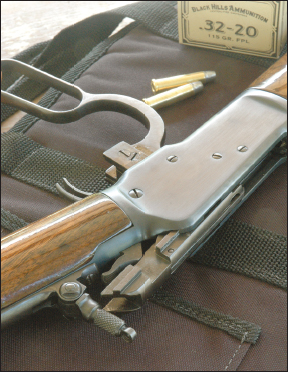4. Breech-Loaders at Last!
Development of the percussion cap energized inventors focused on a breech–loading rifle. While firearms with a hinged breech date to at least 1537, little practical advantage was possible without the percussion cap. Neither did early cartridges advance under flint ignition. The first, assembled in 1586, were of paper. They had no priming, and the guns were still loaded from the muzzle. Biting or ripping off the cartridge base was necessary before loading to expose the charge. The paper burned to ashes upon firing. Replacing pyrite with the percussion cap did away with the biting and tearing because the cap’s more powerful spark could penetrate thin paper.
A major problem early on was building a breechloader stout enough to withstand the heavy powder charges used for hunting big game and reliable enough to keep functioning while hot and dirty. The first American breechloader that won popular acceptance was developed by John Harris Hall in 1811.
Six years later the US government issued a limited number of these rifles to soldiers. But the Hall was weak and crude, a flintlock firing paper cartridges. As war with Mexico threatened to drain US arsenals in 1845, factories fell back to producing the Harpers Ferry muzzle–loading rifle, a design dating to 1803!
Johann Nikolaus von Dreyse was among the first inventors to install a primer in a cartridge. The bullet, actually, held the pellet, inside a paper hull. A long striker penetrated the charge to pinch the pellet against the bullet. The von Dreyse “needle gun,” developed in 1835, became very popular. About 300,000 were built for the Prussian army over the next 30 years. (Incidentally, the “needle gun” mentioned by post-Civil War writers was not the European Dreyse. It was the .50–70 Springfield that became in 1873 the .45–70 “trap–door” rifle used in the last of the Indian Wars. Its long breech block required a needle like striker.)
Meanwhile, Eliphalet Remington bought (for $2,581) the gun company and services of William Jenks, a bright Welsh engineer who had designed a breech loading service rifle but had wearied of awaiting a reply from the US government. Remington adapted the Jenks rifle to use Edward Maynard’s percussion lock, which advanced caps on a strip of paper. Later J. H. Merrill improved the Jenks rifle. In government tests, its tallow coated cardboard cartridges fired reliably, even after a minute’s submersion in water.
During the mid–nineteenth century, rail transport, meat markets, and immigrants establishing homesteads on the Great Plains exacted a heavy toll from wildlife. But development of self–contained rifle cartridges accelerated its decline as no single event had before.
In 1847 Stephen Taylor patented a hollow base bullet with an internal powder charge held in place by a perforated cap that admitted sparks from an external primer. The following year, New York inventor Walter Hunt devised a similar bullet with a paper–covered cork cap. Primer sparks shot through the paper to ignite the charge. What made Hunt’s “rocket ball” exciting, however, was his repeating rifle to fire them. The Hunt “Volitional Repeater” had a brilliantly conceived tubular magazine, and a pillbox mechanism to advance the metallic primers. But the action, operated by a finger lever under the breech, was prone to malfunction. Lacking the money to promote or even improve his rifle, Hunt sold patent rights to fellow New Yorker and machinist George A. Arrowsmith. In Arrowsmith’s shop a talented young engineer named Lewis Jennings began correcting design deficiencies in the Hunt repeater.

The first popular American breechloader was developed by John Hall in 1811.
In 1849, after receiving patents for Jennings’ work, Arrowsmith sold the Hunt rifle for $100,000 to railroad magnate and New York hardware merchant Courtland Palmer. With Palmer’s financial backing, designers Horace Smith and Daniel Wesson began work in 1852 on a metallic cartridge like that patented in 1846 and 1849 by the Frenchman Flobert. Rather than using a ball atop a primer as Flobert had, Smith and Wesson modified a rocket ball to include a copper base that held the fulminate priming. The pistols they fashioned for this ammunition failed to sell. In 1854 Courtland Palmer invested $10,000 in new tooling to bankroll a new partnership with his employees, and a firm that would become known as Smith and Wesson.

The 1874 .50-caliber Sharps rifle was favored by most buffalo hunters.
In 1855 a group of 40 New York and New Haven investors bought out Smith and Wesson and Palmer to form the Volcanic Repeating Arms Company. The investors chose one of their own as company director: a shirt salesman named Oliver F. Winchester. He moved the enterprise from Norwich to New Haven. When sluggish sales of Volcanic guns sent it into receivership in 1857, Winchester bought all assets for $40,000. He reorganized the company into the New Haven Arms Company, and hired Benjamin Tyler Henry as chief mechanic. In 1860 Henry received a patent for a 15–shot repeating rifle chambered for .44 rimfire cartridges. The brass–frame Henry would father Winchester’s first lever rifles: the 1866, 1873, and 1876. Confederates called the Henry “that damned Yankee rifle you loaded on Sunday and fired all week.” Underpowered, prone to leak gas, and marginally reliable, it was nonetheless coveted by hunters as well as soldiers because it could be recharged with a flick of the hand.
The middle of the nineteenth century was the most active period in the history of firearms design. Many inventors threw all their energy into repeating rifle designs, but young Christian Sharps decided to build a better breech–loading single–shot. Sharps, a New Jersey native, had worked under John Hall at the Harpers Ferry Arsenal. In 1848 he received his first patent for a mechanism with a sliding breechblock. Fitted to an altered 1841 Springfield, the prototype could handle powerful loads. Alas, Sharps failed to give it a proper launch at market. He was bailed out by businessman J. M. McCalla and gunsmith A. S. Nippes. A couple of decades later, five years before Christian Sharps succumbed to tuberculosis, the Sharps Rifle Manufacturing Company introduced the New Model 1869, its first rifle in metallic chamberings.
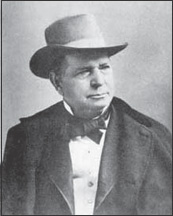
Oliver Winchester invented the volcanic repeating rifle in 1854.
The New Model 1874 appeared the next year, a rifle targeted to market hunters. George Reighard was one. In a 1930 edition of the Kansas City Star, he explained how he shot bison:
“In 1872 I organized my own outfit … to shoot buffaloes for their hides. I furnished the team and wagon and did the killing. (My partners) furnished the supplies and did the skinning, stretching and cooking. They got half the hides and I got the other half. I had two big .50 Sharps rifle with telescopic sights….
“The time I made my biggest kill I lay on a slight ridge, behind a tuft of weeds 100 yards from a bunch of a thousand buffaloes that had come a long distance to a creek, had drunk their fill and then strolled out upon the prairie to rest, some to lie down…. After I had killed about twenty-five my gun barrel became hot and began to expand. A bullet from an overheated gun does not go straight, it wobbles, so I put that gun aside and took the other. By the time that became hot the other had cooled, but then the powder smoke in front of me was so thick I could not see through it; there was not a breath of wind to carry it away, and I had to crawl backward, dragging my two guns, and work around to another position on the ridge, from which I killed fifty-four more. In one and one-half hours I had fired ninety-one shots, as a count of the empty shells showed afterwards, and had killed seventy-nine buffaloes….”
The Sharps Rifle Company folded in 1880, having failed to market its hammerless Model 1878 rifle or design a practical repeater. A peacetime military budget and the decimation of game by commercial hunters contributed to the firm’s collapse. By the early 1880s, so many bison had been killed that human scavengers would glean more than three million tons of bones from the plains.
Meanwhile, a young man began fashioning even more effective firearms. He was John Moses Browning, son of gunsmith Jonathan Browning, who arrived on Utah’s Wasatch Front in 1852, five years after the first of his Mormon brethren completed the trip from Nauvoo, Illinois. John was born in 1855, one of Jonathan’s 22 children. The lad showed an early knack for gun design and by the time he was 11 had built a working shotgun. Later he ran his father’s shop. In 1878, shortly after turning 23, John designed a breech loading single–shot rifle. He built its prototype by hand, with files, chisels, and a foot-lathe his father had brought from Illinois. In May 1879, he received a patent for the dropping–block mechanism.
At this time, the Winchester Repeating Arms Company was a behemoth, with a net worth of $1.2 million. By 1875 it had reached an output of a million cartridges per day. Nonetheless, declining demand for military rifles and ammunition prompted the company to shift its focus in the late 1870s. For the next 36 years it would cater primarily to hunters. To that end it developed the Model 1876 lever rifle, a big, iron–frame version of the popular Model 1873, whose roots reached to Walter Hunt’s Volitional repeater. But the 1876, while massive, lacked the strength to bottle pressures from the .45–70, a favorite not only of ex-soldiers but of elk and bison hunters. Then, in 1883, a Winchester salesman showed company president Thomas Bennett a single–shot rifle he had bought, used, during a trip west. The action was of clever design and evidenced great strength. The maker, whose name Bennett did not recognize, had a shop in Ogden. Bennett booked train passage there immediately.
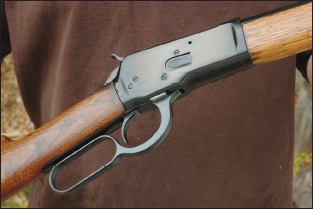
Winchester’s 92, a Browning design, was a huge hit. Phil Filing and Doug Mosier restored this one.
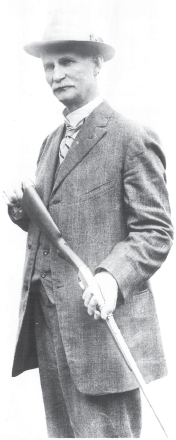
America’s premier gun designer John Browning brought stout, reliable repeating rifles to the western frontier. He later tapped the energy of fired cartridges to cycle autoloading mechanisms, as in the .22 rifle he’s holding here.
He arrived to find a group of brothers barely out of their teens, laboring in a small facility under a sign proclaiming it the “Largest Arms Factory Between Omaha and The Pacific.” The boss, John, was 28. Bennett came straight to the point: He wanted to buy all rights to the single-shot. John said he could have them for $10,000. Bennett countered at $8,000; Browning accepted. It was the start of a relationship that would last 17 years and yield 40 gun designs for Winchester. Thomas Bennett was on the train back to New Haven six hours later.
Barely had Winchester dubbed Browning’s rifle the Model 1885 than John and his brother Matt arrived at company headquarters with a new idea: a repeating lever–action rifle that would handle the .45-70. Bennett bought the design, reportedly for $50,000—or, as John would say later, “more money than there was in Ogden.” The rifle later became Winchester’s Model 1886. John Browning returned from his two year Mormon mission in March, 1889, to design more firearms. During the next four years, he garnered 20 patents. His primary contribution to Winchester was the 1892, a petite lever–action with the Model 86’s vertical locking lugs. The ‘92 would spawn the Model 1894, designed for black powder but chambered in 1895 for the .30-30, America’s first centerfire smokeless round.
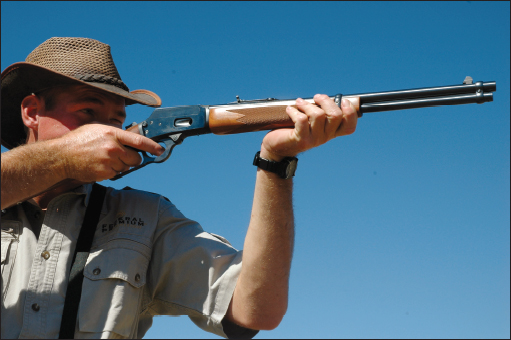
The Marlin Model 1894, not as celebrated as Winchester’s M94, was sturdy, reliable, accurate. This modern version chambers the .357 Magnum.
Development of the metallic cartridge accelerated the pace of rifle design in Europe too, thanks in large part to a talented young German.
Table of contents
- Title Page
- Dedication
- Copyright
- Acknowledgments
- Foreword
- CONTENTS
- INTRODUCTION
- SECTION I: BALLISTICS IN HISTORY
- SECTION II: THE MUSCLE BEHIND THE SHOT
- SECTION III: BULLETS—THE INSIDE STORY
- SECTION IV: SPEED, ENERGY, AND ARC
- SECTION V : PUTTING BALLISTICS TO WORK
- SECTION VI: FOR LONGER REACH
- BALLISTICS TABLES FOR MODERN SPORTING RIFLES
- GLOSSARY
